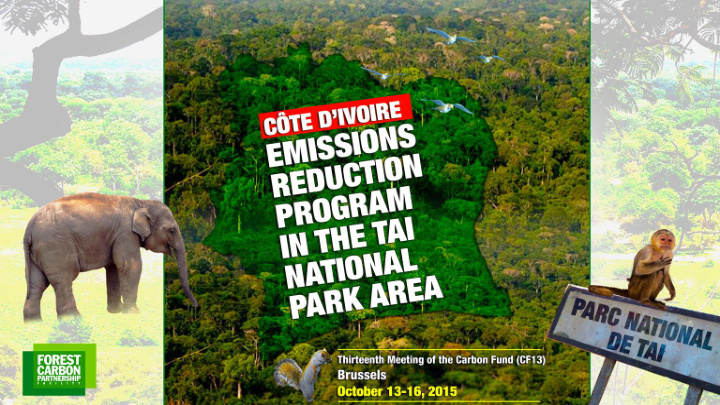



C ô te d’Ivoire ER-PIN ER Program Idea Background/Context Economy based on agriculture: Cocoa : biggest producer worldwide (30-40% of world production) but among the lowest global yields; Palm oil : ranked 1st in Africa, 5th worldwide; Rubber : ranked 1st in Africa, 7th worldwide (2012) Country is at risk of losing its entire forested area by 2030 if nothing is done ER program is perfectly aligned with national REDD+ strategy including reforms and institutional framework ER program combines political commitment and private sector initiatives in one sub-national geography to address agricultural drivers of deforestation The country’s last remaining large forest bloc is within program area 2
C ô te d’Ivoire ER-PIN Program Highlights Political will very well established: Commitment to zero-deforestation agriculture Existing Inter-ministerial Task Force overseen by the Ministry of Plan responsible for the elaboration of the National Development Plan Strong involvement of private sector to implement zero-deforestation agriculture Effective participation of civil society organized in a joint platform of the FLEGT and REDD+ processes (OIREN) Includes 18 classified forests + Taï national Park (UNESCO World Heritage site and biosphere reserve, 530 000 ha of contiguous tropical rainforest, largest forest bloc in West Africa) High historical deforestation rate and current hot spot of cocoa production high potential to reduce deforestation 3
C ô te d’Ivoire ER-PIN Scale Located in the South-West Area: 4 256 786 ha (13% of national territory) Population: 3 659 904 inhabitants (RGPH, 2014) 5 of 32 of the county’s regions (Cavally, Nawa, San Pedro, Guemon and Gboklè) Current hot spot of cocoa, main area for development of palm oil and rubber plantations 4
C ô te d’Ivoire ER-PIN Country progress towards Readiness Dons préparatoire de 650 000 USD 5
C ô te d’Ivoire ER-PIN Political Commitment Integration of REDD+ in the INDC (2015), Republic’s President at the New York Declaration on Forests (2014): Commitment to transition towards zero -deforestation agriculture by 2017 including “Ivorian zero - deforestation cocoa” and restore forest cover (20%) Initiative for sustainable palm oil of Tropical Forest Alliance (TFA) 2020: national interpretation of criteria Cross-sectoral dialogue: Inter-ministerial Technical Committee + Inter-Ministerial Task Force to integrate REDD+ in the general law on agriculture and the land use planning policy, “green” the next National Development Plan (2016 -2020) and elaborate an evaluation framework for projects to be included in the next NDP Establishment of National REDD+ Commission by Degree in 2012; New forest law (2014); Financial contribution of the government to the REDD+ process
C ô te d’Ivoire ER-PIN Drivers and proposed program activities DRIVERS Extension of agricultural Weak forest governance & Logging for wood energy Illegal mining activities Cross-cutting activities production areas illegal logging production (small-scale) PROPOSED PROGRAM ACTIVITIES Zero-deforestation • Capacity building for • Reforestation with fast- • Support to optimize • PES agriculture in partnership forest monitoring growing species for mining activities • Support regarding land with the private sector • Participatory energy production • Restoration of mining tenure certificates - Agricultural management of classified • Promotion of improved sites • Elaboration of a regional intensification forests and NPs cook stoves • Alternative activities to land use plan for the 5 - Agroforestry • Capacity building of civil • Promotion of alternative illegal mining regions - Regeneration of land society for independent solutions to charcoal (e.g. • Family planning lots observer functions agricultural biomass) • Basic education • Support of FLEGT 7
C ô te d’Ivoire ER-PIN Reference Level Reference period : 2003-2013 Activities : Deforestation, forest degradation, enhancement of forest carbon stocks Sources : Aboveground biomass Methodology : Historical average Estimation of emission reductions 2018-2024: - Deforestation: 194,885 ha (27,840 ha / year) - Total net emissions from deforestation (7 years): 110.55 millions tCO2eq Land uses 2013 8
C ô te d’Ivoire ER-PIN Emission Reduction Generated Table : Reduction of emissions generated by the program (2018 – 2024) Annual Enhancement of Emissions Absorptions Total net Reduction Year deforestation carbon stock from related to Emissions reduced emissions rate (ha) (ha) deforestation ERP 2018 27,840.72 4,000 15,794,040.46 31,476 15,762,564.46 0.1 1,610,880.05 2019 27,840.72 8,000 15,794,040.46 94,428 15,699,612.46 0.2 3,253,236.09 2020 27,840.72 8,000 15,794,040.46 157,380 15,636,660.46 0.2 3,316,188.09 2021 27,840.72 8,000 15,794,040.46 220.332 15,573,708.46 0.2 3 379 140.09 2022 27,840.72 8,000 15,794,040.46 283,284 15,510,756.46 0.2 3 442 092.09 2023 27,840.72 8,000 15,794,040.46 346,236 15,447,804.46 0.2 3 505 044.09 2024 27,840.72 10,000 15,794,040.46 424,926 15,369,114.46 0.3 5 163 138.14 TOTAL 23 669 718,64 Volume proposed to Carbon Fund (2018-2022): 70% ER purchased by CF, 10% other buyers 10% for uncertainty, 10% buffer reserve 9
C ô te d’Ivoire ER-PIN Non-carbon benefits Socio-Economic Benefits Environmental Benefits: Diversification and increase of income; Preservation of forest frontiers; Food security; Conservation of biodiversity; Sustainability of production systems; Soil protection and fertilization; Job creation, in particular for most Preservation of water quality; vulnerable groups (women and youth); Improvement of micro-climate. Reduction of conflicts. 10
C ô te d’Ivoire ER-PIN Diversity and learning value 1. Strong political commitment of the government to operationalize zero-deforestation agriculture 2. Inter-ministerial coordination already established 3. Active participation of private sector and emergence of Public-Private Partnerships: Chocolatiers like Cemoi, Mondelez and their suppliers (Olam, Cargill) have expressed their commitment to implement the zero-deforestation approach throughout their supply chains in the ER program 4. High potential of emission reductions and high delivery capacity 11
12
Recommend
More recommend